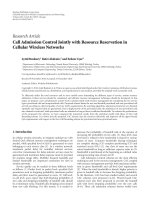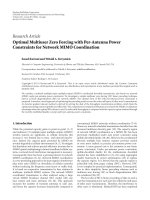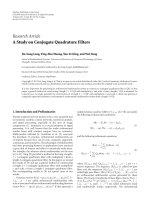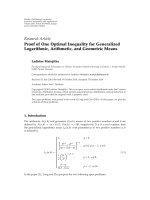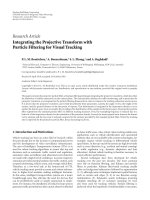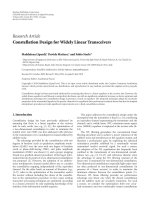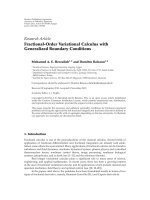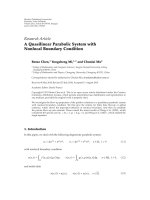Báo cáo hóa học: " Research Article Call Admission Control Jointly with Resource " doc
Bạn đang xem bản rút gọn của tài liệu. Xem và tải ngay bản đầy đủ của tài liệu tại đây (836.98 KB, 10 trang )
Hindawi Publishing Corporation
EURASIP Journal on Wireless Communications and Networking
Volume 2010, Article ID 740575, 10 pages
doi:10.1155/2010/740575
Research Article
Call Admission Control Jointly with Resource Reservation in
Cellular Wireless Networks
Ayt
¨
ul Bozkurt,
1
Rafet Akdeniz,
2
and Erdem Uc¸ar
3
1
Department of Electronics Technology, Namık Kemal University, 59860 Tekirda
˘
g, Turkey
2
Department of Electronics and Telecommunication Engineering, Namık Kemal University, 59860 Tekirda
˘
g, Turkey
3
Department of Computer Engineering, Trakya University, 22100 Edirne, Turkey
Correspondence should be addressed to Ayt
¨
ul Bozkurt,
Received 9 November 2010; Accepted 25 December 2010
Academic Editor: Nicholas Kolokotronis
Copyright © 2010 Ayt
¨
ul Bozkurt et al. This is an open access article distributed under the Creative Commons Attribution License,
which permits unrestricted use, distribution, and reproduction in any medium, provided the original work is properly cited.
To efficiently utilize the total resources and to serve mobile users demanding for different types of service, system resource
utilization of these services should be considered, and efficient resource management techniques should be developed. In this
paper, we propose a new call admission control (CAC) scheme jointly with resource management by considering the two service
types: prioritized calls and nonprioritized calls. Proposed scheme limits the new and handoff prioritized and non-prioritized call
arrivals according to call-level quality of service (QoS) requirements. By searching algorithm, admission parameters are obtained
optimally and required QoS are guaranteed. Due to high priority of the prioritized calls, the admittance of non-prioritized calls
into channel is restricted, while prioritized calls are admitted as long as there is sufficient bandwidth. To evaluate the performance
of the proposed CAC scheme, we have compared the numerical results from the analytical model with those of New Call
Bounding scheme. It is shown that the proposed CAC scheme uses the resources effectively and improves all the upper-bound
QoS requirements with respect to the New Call Bounding scheme for prioritized and non-prioritized users.
1. Introduction
In cellular wireless networks, to integrate multiservice with
desired QoS, efficient resource management techniques are
needed, while specified level of QoS is guaranteed to users
belonging to each service class [1]. In a wireless network,
maximum packet delay for nondelay tolerant services,
error-free transmission for delay-tolerant services must be
guaranteed and maximum delay response must be provided
for seamless image effect. Mobility, frequent handoffsand
limited bandwidth are important constraints for QoS in
wireless networks.
Service quality can be studied in three different levels
as follows. (1) Packet level: in packet level, specified QoS
parameters such as dropping probability, maximum packet
delay and jitter must be guaranteed to users. (2) Call level:
in call level, users expect that both blocking probability of
new calls and dropping probability of handoff calls should
be at minimum value. Handoff calls dropping is less desired
than new calls blocking. For this reason, it is needed to
decrease the probability of handoff calls at the expense of
increasing the probability of new calls. (3) Class level: class
level QoS is related to how bandwidth is shared by various
classes of users. Common bandwidth sharing techniques
are complete sharing (CS) complete partitioning (CP) and
restricted access (RA) [2]. Any class of users can use the
entire bandwidth as long a s sufficient capacity exists in CS.
Bandwidth is partitioned at the beginning as a default value
among incoming class of users in CP.
Call Admission Control schemes are the most efficient
techniques used in the resource management. CAC coupled
with resource management provides both maximum utiliza-
tion in given bandwidth and call-level QoS requirements
[3]. When the total bandwidth is shared, higher priority is
given to handoff calls to decrease the dropping probability.
In the literature, CAC has been studied widely and several
CAC schemes were proposed [4–12]. Priority-based CAC
schemes have also been proposed to provide the handoff
calls with lower dropping probability over the new calls
[4–6]. Three call admission schemes known widely have
2 EURASIP Journal on Wireless Communications and Networking
been studied for different channel holding times of the
new and handoff calls for only one service in [4]and
a new approximation approach was proposed to reduce
the computational complexity. In [5], exact product-form
solution is studied to evaluate the symmetric CAC schemes
such as New Call Bounding scheme in multiservice networks
where different channel holding times of all the classes of
calls are different. In [6], for multiple priorities, elastic-
threshold-based CAC was designed and its performance was
evaluated in terms of maximum reward obtainable with
QoS satisfaction and threshold values were determined by
sequentially adjusting the thresholds based on reward and
reject rate.
CACschemeproposedin[7] supports multiple admis-
sion priority classes. Proposed scheme adopts dynamic guard
loading concept in which it adapts the threshold limits based
on the current estimates of multiple handoff classes requests
derived from current number of ongoing calls in neighboring
radio cells and the mobility pattern. Another priority-based
scheme is proposed and analyzed for integrated voice and
data based on resource preemption [8]. Proposed scheme
deploys RA bandwidth sharing technique in which high-
priority prioritized calls can all bandwidth unrestrictive
way when there is enough capacity. If there is unoccupied
bandwidth by prioritized calls upon the arrival of a new
or handoff data calls, arriving data calls use the remaining
bandwidth from the prioritized calls. This leads to available
bandwidth usage of the data calls and better system resource
utilization and performance results. In [9, 10], optimal
CAC is proposed by adopting the semi-Markov Decision
Process (SMDP) to model the call admission scheme and
bandwidth reallocation algorithm at the same time for
time-varying multimedia traffic. A dynamic priority CAC
is proposed in [11] to achieve better balance between CS
and CP by computing the dynamic prior ity l evel based on
predefined load partitions and the current carried load. In
[12], two types of traffic are considered and partitioned
to four priority classes; bandwidth reservation is made
according to priority class. Although proposed scheme
reserves different amounts of bandwidth for each prioritized
class, bandwidth reservation thresholds are not optimal
values.
In this paper, we propose a new call admission control
scheme with adjusted capacity allocation to utilize the net-
work resources efficiently. The main novelty in the proposed
scheme is that maximum K (kbps) amount of adaptable
bandwidth is allocated to nonprioritized calls and this value
is determined optimally by considering E[T
n
1
]andBN
1
call
level requirements to protect the nonprioritized calls from
QoS degradation. Further, by searching algorithm, admis-
sion region is derived for prioritized and nonprioritized calls.
This paper is organized as follows. In Section 2, the
system model that we considered is described. In Section 3,
we propose a new CAC policy, present an analytical model
by using Markov model and obtain the optimal admis-
sion values with developed algorithms. Section 4 co mpares
performance results from analytical model with those
of New Call Bounding scheme. Section 5 concludes the
paper.
2. System Model
We considered that wireless cellular network has a number
of base stations and the coverage of a base station is
rounded by a cell. Network contains two traffictypes:
prioritized traffic calls and nonprioritized traffic calls. A
mobile initiating a new prioritized or nonprioritized call
when crossing the cell boundary towards the outside of
the coverage, can still maintain seamless traffic transmission
by handoff occurrence. It is assumed that system is in
statistical equilibrium, where the mean rate of handoff arrival
calls is equal to the mean rate of handoff departure calls
in the cell and rounded six cells have the uniform traffic
conditions. With these assumptions, single cell is referenced
and system performance analysis is evaluated from single cell
performance.
Arriving calls at the cell are new and handoff prioritized
calls and nonprioritized calls. As nonprioritized calls (such
as data) can tolerate delay, they use the same total bandwidth
reserve and the equal priority is given to new and handoff
nonprioritized calls. Prioritized calls (such as voice) cannot
tolerate delay, to maintain the seamless transmission; dif-
ferentiation between the new and handoff calls is required
for prioritized traffic calls. As dropping an ongoing handoff
prioritized call is less desired than blocking a new prioritized
call arrival, an amount of capacity C is re served as a guard
channel for only handoff prioritized call arrivals. New and
handoff call arrivals to cellular system are assumed to be
Poisson arrival process. Prioritized and nonprioritized call
duration and the cell residence time are assumed to be
exponentially distributed with means 1/μ
dr
1
,1/μ
r
1
,1/μ
dr
2
,
and 1/μ
r
2
, respectively. The channel o ccupancy time of
prioritized call μ
−1
2
is also assumed to be exponentially
distributed with mean 1/(μ
dr
2
+ μ
r
2
)[13, 14]. Nonprioritized
calls can adapt to varying bandwidth traffic conditions;
here, call admission control scheme admit new and handoff
nonprioritized calls without dropping bandwidth below the
minimum pre-determined level. Call duration for nonprior-
itized calls, on the other hand, depends both on bandwidth
left over to each nonprioritized call and nonprioritized
call file size. Although nonprioritized calls file size is not
distributed exponentially for tractability in the mathematical
analysis [15, 16], it is assumed to be exponentially distributed
with mean 1/μ
f
n
1
. The channel occupancy time μ
−1
1
also is
exponentially distributed with means 1/(μ
dr
1
+ μ
r
1
).
3. Call Admission Scheme
Proposed CAC policy uses (CS) access in which both
prioritized and nonprioritized calls can use all the capacity
according to the CAC policy limitations as shown in Figure
1. However, due to their lower priority, policy limits the
admission of nonprioritized calls into the network and also
limits the bandwidth that can be used by new and handoff
nonprioritized calls. The number of nonprioritized calls that
will be admitted to the network is determined optimally
in accordance with CAC policy’s QoS considerations on
nonprioritized calls such as upper bound of mean call
response time and blocking/dropping probability under
EURASIP Journal on Wireless Communications and Networking 3
K (Mbps)
n
2
<N
2
− M calls
M (optimal with N
1
)
M (optimal with N
1
)
n
2
≥ N
2
− M calls
C
− n
2
c
2req
(Mbps)
Total bandwidth, C (Mbps)
N
2
calls
N
2
calls
N
1
calls(0 <n
1
≤ N
1
)
N
1
calls(0 <n
1
≤ N
1
)
Figure 1: Resource (total bandwidth) reservation scheme.
varying traffic load conditions. New prioritized calls can use
up to certain bandwidth at the system. Handoff prioritized
calls c an use the entire bandwidth over all the nonprioritized
calls (new or handoff). Minimum T
2
and maximum N
2
,
where N
2
is the number of new and handoff prioritized calls
and T
2
is the number of new prioritized calls allowed, can be
determined optimally by the CAC searching algorithm given
in Algorithm 1.
Since prioritized calls cannot tolerate the delay, they
require constant c
2req
amount of bandwidth to meet their
QoS requirements. Whereas nonprioritized calls can tolerate
the certain amount of delay, their required bandwidth
amount can be adaptable to varying bandwidth. Proposed
CAC scheme reserves at most optimal K (Mbps) band-
width determined by searching algorithm in Algorithm 1 to
nonprioritized calls w hen the total number of prioritized
calls at the system is less than N
2
− M,whereM is
the optimal threshold number for nonprioritized calls and
reserves remaining C
− n
2
c
2req
(Mbps) bandwidth when the
number of prioritized calls is more than N
2
− M.Actually,
this admission scheme defines the New Call Bounding
admission scheme which limits the new calls number (N
1
)
with a threshold (M); if the number of new calls does
not exceed the threshold, it is admitted; otherwise, it is
blocked, while handoff calls is rejected only when there
is no bandwidth in the system. But this scheme assumes
that all prioritized and nonprioritized calls require constant
bandwidth and reserves constant bandwidth for the delay-
tolerant calls, that is, nonprioritized calls. It leads to lack
of capacity using for delay-tolerant calls in their upper
bound of reserved bandwidth while there is no prioritized
call at the system. Without any change in the optimal M
threshold number, proposed CAC policy in conjunction with
bandwidth reservation, changes the reserved area for the
nonprioritized calls dynamically upon each new prioritized
call arrival. Admission policy for proposed CAC is given in
Algorithm 2.
Optimal CAC parameters for prioritized and nonprior-
itized calls can be obtained as follows from Algorithm 1.
Steps (1)–(3) determine the largest number of prioritized
calls (C/c
2req
) that channel can accommodate with minimum
bandwidth requirement of prioritized calls, if blocking
probability is larger than required level, the algorithm stops
due to insufficient channel capacity. N
2
is searched by
increasing the N
2
in each searching step until prioritized
calls blocking probability BN
2
is smaller than the required
blocking probability. Maximum value of N
2
cannot exceed
the calls (C/c
2req
). Steps (4)–(8) determine the maximum
value of T
2
by equalizing T
2
to N
2
first and by decreasing
T
2
in each searching step, until pr ioritized calls dropping
probability BH
2
is smaller than the required dropping
probability. Steps (9)-(10) first start from N
1
= 1, computing
M threshold number and steps (11)–(19) compute c
1
(n
1
, n
2
)
reserved bandwidth for nonprioritized calls jointly with
steady-state probability of prioritized calls, N
1
and M.
BN
1
is the blocking probability of the new prioritized
calls and E[T
n
1
] is the mean response time of nonprioritized
calls. To determine the number of nonprioritized cal l s N
1
,
two restrictions (E[T
n
1
], BN
1
) are considered under the
control of optimal tradeoff consisting of an increase in
nonprioritized calls response t ime and a decrease in the
blocking probability of nonprioritized calls by increasing the
number of admitted nonprioritized calls to the system. Steps
(20)–(22) search the maximum N
1
and M in each search step,
until two restrictions are satisfied, and step (23) outputs the
obtained results.
3.1. New Call Bounding Scheme. This scheme limits the
admission of nonprioritized calls into the system to provide
the call-level QoS requirements for handoff prioritized calls
while a cceptable QoS requirement is still guaranteed to
nonprioritized calls. M is the threshold number for the
nonprioritized calls. If the number of nonprioritized calls
exceeds M, they are blocked, otherwise admitted. K, when
the number of prioritized calls is less than N
2
− M in
the system, defines maximum bandwidth amount reserved
for nonprioritized calls. New and handoff prioritized and
nonprioritized call arrivals are assumed to be Poisson arrival
process with mean rate λ
n
1
, λ
h
1
, λ
n
2
,andλ
h
2
,respectively[4].
The offered prioritized and nonprioritized loads when
prioritized and nonprioritized call users are in the system
are given by ρ
1
= λ
1
/μ
1
, ρ
2
= λ
2
/μ
2
and λ
1
= λ
n
1
+ λ
h
1
,
λ
2
= λ
n
2
+ λ
h
2
,whereλ
1
and λ
2
are the total mean arrival
rate of prioritized and nonprioritized calls. c
1req
denotes
the required capacity to maintain the QoS requirements for
nonprioritized calls. When there are n
1
nonprioritized calls
and n
2
prioritized calls in the system, the probability of these
n
1
and n
2
nonprioritized and prioritized calls in the system
is given by a product-form solution as follows
n
1
c
1req
+ n
2
c
2req
≤
C,0≤ n
1
c
1req
≤ K,
π
(
n
1
, n
2
)
=
ρ
n
1
1
n
1
!
·
ρ
n
2
2
n
2
!
· π
(
0, 0
)
,
(1)
where
π
(
0, 0
)
=
⎡
⎣
(
n
1
,n
2
)
∈S
ρ
n
1
1
n
1
!
·
ρ
n
2
2
n
2
!
⎤
⎦
−1
=
⎡
⎣
K/c
1req
n
1
=0
ρ
n
1
1
n
1
!
·
C−((n
1
·c
1req
)/c
2req
)
n
2
=0
ρ
n
2
2
n
2
!
⎤
⎦
−1
.
(2)
4 EURASIP Journal on Wireless Communications and Networking
(1) N
2
= 1; %T
d upper
, QN
1
(QH
1
), QN
2
(QH
2
) are upper bounds.
(2) while (BN
2
<QN
2
)
(3) N
2
= N
2
+1subjectto0≤ N
2
≤ C/c
2req
(4) T
2
= N
2
(5) end
(6) while (BH
2
<QH
2
)&&(T
2
> 0)
(7) T
2
= T
2
− 1
(8) end
(9) N
1
= 1
(10) M
= (N
1
· c
1req
)/c
2req
(11) for n
1
= 1:N
1
(12) for n
2
= 1:N
2
− M
(13) c
m
(n
1
, n
2
) = K
(14) for n
2
= (N
2
− M)+1:N
2
(15) c
m
(n
1
, n
2
) = (N
2
− n
2
) · c
2req
(16) end
(17) c
1
(n
1
, n
2
) = π(n
2
) · c
m
(n
1
, n
2
)
(18) end
(19) end
(20) while (E[T
n
1
] <T
d upper
&& (BN
1
<QN
1
)
(21) N
1
= N
1
+1, M = (N
1
· c
1req
)/c
2req
(22) end
(23) Output (N
1
, N
2
, T
2
, M)
Algorithm 1: Determining algorithm of optimal number of the prioritized and nonprioritized calls.
The state space is defined as S={( n
1
, n
2
)| 0≤n
1
≤K/c
1req
,
0
≤ n
1
+ n
2
≤ C}.
Thus, nonprioritized call blocking and prioritized call
dropping probabilities can be obtained as
BN
1
=
(C−N
1
·c
1req
)/c
2req
n
2
=0
π
(
M, n
2
)
,
BN
1
= BH
1
,
BN
2
=
N
1
=M
n
1
=0
π
(
n
1
, C − n
1
)
,
BN
2
= BH
2
,
(3)
where
represents the floor function that rounds its input
to the nearest integer less than or equal to the value of input
itself.
The mean nonprioritized calls response time is obtained
by division of total mean number of nonprioritized calls
[E
n
1
] in the system to the mean call arrival rate H, which
is known as Little’s law [17]. In New Call Bounding
scheme, capacity for the delay-tolerant calls, that is, for
nonprioritized calls, is constant and does not change with the
increase or decrease in the number of other types of calls in
the system; hence, the purpose of this paper is to show the
impacts of changeable capacity on system performance with
the same number of users as those of New Call Bounding
scheme. E[T
n
1
] is defined as the mean nonprioritized calls
response time and calculated as
E
T
n
1
=
E
[
n
1
]
H
=
K/c
1req
n
1
=0
n
1
· π
(
n
1
)
(
1
− BN
1
)
λ
n
1
+
(
1 − BH
1
)
λ
h1
=
K/c
1req
n
1
=0
n
1
·
C−((n
1
·c
1req
)/c
2req
)
n
2
=0
π
(
n
1
, n
2
)
(
1
− BN
1
)
λ
n
1
+
(
1 − BH
1
)
λ
h
1
.
(4)
Total channel utilization efficiency n is the ratio of used
bandwidth and the total system bandwidth. From all the
users’ channel occupancy probabilities, n is calculated as;
n
=
K/c
1req
n
1
=0
C−((n
1
·c
1req
)/c
2req
)
n
2
=0
π
(
n
1
, n
2
)
·
n
1
c
1req
+ n
2
c
2req
C
.
(5)
Total mean throughput (calls/s) is the mean rate that all
nonprioritized calls are served and calculated as
γ
=
K/c
1req
n
1
=0
C−((n
1
·c
1req
)/c
2req
)
n
2
=0
π
(
n
1
, n
2
)
· n
1
·
μ
r
1
+
c
1req
f
n
1
,
(6)
where f
n
1
is the mean file size for nonprioritized calls.
EURASIP Journal on Wireless Communications and Networking 5
When a prioritized (new) call arrives
if (the total number of prioritized calls <T
2
)
admit the call
else reject the call
When a prioritized (handoff ) call arrives
if (the total number of prioritized calls <N
2
admit the call
else reject the call
When a non-prior. (new or handoff) call arrives
if (the total number of prior. calls <N
2
− M)
allocate the (K) bandwidth to the nonprioritized calls
N
1
= N
1
+1
compute E[T
n
1
], BN
1
if (E[T
n
1
] <Q[T
n
1
]) && (BN
1
<QN
1
)
admit the call
else reject the call
else if (the total number of prior. calls
≥ (N
2
− M)
allocate the (remaining) bandwidth
N
1
= N
1
+1
compute E[T
n
1
], BN
1
if (E[T
n
1
] <Q[T
n
1
]) && (BN
1
<QN
1
)
admit the call
else reject the call
Algorithm 2: Proposed CAC policy.
3.2. Proposed CAC Scheme. Proposed CAC scheme handles
the nonprioritized and prioritized calls separately. Firstly,
when the proposed CAC scheme admits both traffictypesof
calls into system behaves in the same admission policy with
that of New Call Bounding scheme described in Section 3
except that Proposed CAC policy provides with adaptable
bandwidth reservation instead of fixed bandwidth set in the
system. Secondly, in the proposed CAC policy, each type of
calls is analyzed by one-dimensional Markov chain model
based on their service type. Since nonprioritized calls can use
bandwidth amount determined by Algorithm 1, steady-state
probability π(n
1
), in which n
1
calls are in the system, can be
obtained by M/G/1/K-PS queue model [18]. Prioritized calls
require certain capacity due to their nontolerant structure to
delay; their steady-state probabilities π(n
2
), in which n
2
calls
are in the system, can be obtained by M/M/K/K queue model.
3.2.1. Prioritized Calls Resource Allocation. Prioritized traffic
load when the system is in state n
2
is given by ρ
n
2
= ρ
2
.
Steady-state probability π(n
2
) can be obtained by
π
2
(
n
2
)
=
⎧
⎪
⎪
⎪
⎪
⎪
⎨
⎪
⎪
⎪
⎪
⎪
⎩
ρ
n
2
n
2
n
2
!
π
2
(
0
)
,0
≤ n
2
≤ T
2
,
ρ
n
2
n
2
α +
(
1 − α
)
β
n
2
α
n
2
−T
2
−1
n
2
!
π
2
(
0
)
, T
2
+1≤ n
2
≤ N
2
,
(7)
where α is the fraction of the handoff prioritized trafficload,
β is the threshold constant for admitting the new prioritized
calls when n
2
= T
2
,andπ(0), is normalization constant given
by
π
2
(
0
)
=
⎧
⎨
⎩
T
2
n
2
=0
ρ
n
2
n
2
n
2
!
+
N
2
n
2
=T
2
+1
ρ
n
2
n
2
α+
(
1−α
)
β
α
n
2
−T
2
−1
n
2
!
⎫
⎬
⎭
,
(8)
BN
2
=
1 − β
π
2
(
T
2
)
+
N
2
n
2
=T
2
π
2
(
n
2
)
,(9)
BH
2
= π
2
(
N
2
)
.
(10)
3.2.2. Nonprioritized Calls Resource Allocation. Varying
capacity for the nonprioritized calls is given by
c
1
(
n
1
, n
2
)
=
⎧
⎨
⎩
K, n
2
≤ N
2
− M,0<n
1
≤ N
1
,
C
− n
2
c
2req
, n
2
>N
2
− M,0<n
1
≤ N
1
,
n
1
= 0, 1, N
1
, n
2
= 0, 1, N
2
,
(11)
where c
1
(n
1
, n
2
) is the available capacity to nonprioritized
traffic when the system is occupied by n
2
number of
prioritized calls. Total shared bandwidth conditions between
nonprioritized and prioritized calls are given by
K + n
2
c
2req
≤ C,ifn
2
≤ N
2
− M,0<n
1
≤ N
1
,
C − n
2
c
2req
+ n
2
c
2req
= C,ifn
2
>N
2
− M,0<n
1
≤ N
1
,
n
2
c
2req
≤ C,ifn
2
≤ N
2
, n
1
= 0.
(12)
From the M/G/1/K-PS model, the mean nonprioritized
call response time can be determined under nonprioritized
traffic load by considering the variabilities in the service
capabilities of nonprioritized calls. Nonprioritized traffic
load when the system is in state n
2
is given by
ρ
n
1
=
λ
n
1
· f
n
1
c
1
(
n
1
, n
2
)
. (13)
Nonprioritized trafficloadrequiresρ
n
1
< 1 so that system
could be stable for the greater values of ρ
n
1
, the system
becomes unstable and the mean response time of nonprior-
itized calls presents a state out of its maximum value [19].
The mean offered traffic load of nonprioritized calls is given
by
ρ
n
1
(average)
=
N
2
n
2
=0
π
(
n
2
)
·
λ
n
1
· f
n
1
c
1
(
n
1
, n
2
)
. (14)
Threshold number M is calculated numerically from optimal
number of N
1
. c
1req
gets minimum and maximum capacity
6 EURASIP Journal on Wireless Communications and Networking
in the range of (N
2
− n
2
)c
2req
/N
1
≤ c
1req
≤ K/N
1
and (N
2
−
n
2
)c
2req
/[n
1
= 1] ≤ c
1req
≤ K/[n
1
= 1], respectively. M is
given by
M
=
K
c
2req
= N
1
·
c
1req
c
2req
. (15)
Steady-state probability π(n
1
), in which n
1
calls are in the
system, can be obtained as
π
1
(
n
1
)
=
1 − ρ
n
1
(average)
·
ρ
n
1
n
1
(
average
)
1 − ρ
n
1
+1
n
1
(
average
)
,0≤ n
1
≤ N
1
.
(16)
Nonprioritized calls blocking and dropping probabilities can
be obtained as
BN
1
=P
[
N = N
1
]
=
1 − ρ
n
1
(average)
·
ρ
N
1
n
1
(
average
)
1 − ρ
N
1
+1
n
1
(
average
)
, (17)
BN
1
= BH
1
, (18)
where BH
1
is the dropping probability of the handoff
prioritized calls.
The mean response time of nonprioritized calls is calcu-
lated according to Little’s law and given by
E
T
n
1
=
E
[
n
1
]
H
=
N
1
n
1
=0
n
1
π
(
n
1
)
(
1
− BN
1
)
λ
n
1
+
(
1 − BH
1
)
λ
hn
1
. (19)
According to scheme, to determine the bandwidth uti-
lization efficiency, nonprioritized calls (new and handoff)
use K (Mbps) bandwidth at most, and remaining bandwidth
(C
− K) (Mbps) is unoccupied with π
1
(n
1
)π
2
(0) probability
if any priority (new and handoff) call does not arrive to
the system. On the other hand, if any nonprioritized call
(new or handoff) does not arrive to the system, only unoc-
cupied bandwidth corresponds to (C
− n
2
c
2req
)(Mbps)with
π
2
(n
2
)π
1
(0) probability. Utilization efficiency is obtained as
n
= 1 −
π
1
(
0
)
π
2
(
0
)
· C +
N
1
n
1
=1
π
1
(
n
1
)
π
2
(
0
)
·
(
C
− K
)
+ Z
C
,
(20)
where Z denotes
N
2
n
2
=1
π
2
(n
2
)π
1
(0) · (C − n
2
c
2req
).
The mean total throughput can be obtained as
γ =
N
1
n
1
=1
⎛
⎝
N
2
−M
n
2
=0
π
2
(
n
2
)
π
1
(
n
1
)
n
1
·
μ
r
1
+
K
f
n
1
+
N
2
n
2
=
(
N
2
−M
)
+1
π
2
(
n
2
)
π
1
(
n
1
)
n
1
·
μ
r
1
+
C
− n
2
c
2req
f
n
1
⎞
⎠
.
(21)
Overload probability P
ov
is defined as the probability that
capacity used by a nonprioritized call user drops under a
threshold c
1drop
and obtained as,
if
c
1
(
n
1
, n
2
)
n
1
<c
1drop
,
n
1drop
=
c
1
(
n
1
, n
2
)
c
1drop
, n
1
=
n
1drop
, n
1drop
+1, , N
1
,
(22)
P
ov
=
N
1
n
1
=n
1drop
N
2
−1
n
2
=0
π
2
(
n
2
)
π
1
(
n
1
)(
n
1
+ n
2
)
N
1
n
1
=1
N
2
−1
n
2
=0
π
2
(
n
2
)
π
1
(
n
1
)(
n
1
+ n
2
)
. (23)
3.3. Fixed Iterative Algorithm for Calculation of both Non-
prioritized and Prioritized Handoff Calls Arrival Rate. To
begin to compute steady-states probabilities, we should know
the handoff call arrival rates for both types of service. Any
handoff arrival rate for a call type must be equal to handoff
departures rates in a cell. The mean handoff arrival rate can
be determined as [20]
λ
h
1
=
H
1
λ
n
1
(
1
− BN
1
)
1 − H
1
(
1
− BH
1
)
,
λ
h
2
=
H
2
λ
n
2
(
1
− BN
2
)
1 − H
2
(
1
− BH
2
)
.
(24)
We note that determination of handoff arrival rate
depends on the steady-state probability which is unknown
at the begining. By setting the initial values for handoff call
arrival rates and using the iterative approach [21], we can
determine the ac tual handoff arrival rates. Initial values for
λ
h
1
and λ
h
2
can be set as [22]
λ
Hi
1
= λ
n
1
H
1
1 − H
1
,
λ
Hi
2
= λ
n
2
H
2
1 − H
2
,
(25)
where H
1
and H
2
are handoff probability of prioritized and
nonprioritized calls and given as
H
1
=
μ
r
1
μ
r
1
− μ
dr
1
=
μ
r
1
μ
r
1
+
1/E
T
n
1
,
H
2
=
μ
r
2
μ
r
2
− μ
dr
2
.
(26)
With these initial values, we can use the following iterative
algorithm.
Step 1. Set the initial values for λ
h
1
and λ
h
2
according to (25).
Step 2. Calculate the steady-state probabilities; BN
1
, BH
1
,
BN
2
,andBH
2
according to the (7), (16), (9), (10), (17), and
(18).
Step 3. Calculate the mean handoff arrival rates using (24).
EURASIP Journal on Wireless Communications and Networking 7
0.1 0.15 0.2 0.25 0.3 0.35 0.4 0.45 0.5 0.55
0
1
2
3
4
5
6
7
8
9
10
Proposed scheme
New Call Bounding
The mean nonprioritized call
response time, T
n
1
(s)
Prioritizedcallarrivalrate,λ
n
2
(calls/s)
Figure 2: The mean response time of nonprioritized calls versus
prioritized calls arr ival rate.
0.1
0.2
0.3
0.4
0.5
0
0.01
0.02
0.03
0.04
0.05
0.06
0.07
Proposed scheme
Upper bound
Prioritized call dropping probability, BH
2
New Call Bounding
Prioritized call arrival rate, λ
n
2
(calls/s)
Figure 3: Prioritized call dropping probability versus prioritized
calls arrival rate.
Step 4. Let ε (>0) be a predefined small value. If ε is smaller
than the differentiation of (λ
h
1
and λ
Hi
1
), (λ
h
2
and λ
Hi
2
),
algorithm (iteration) goes on, λ
Hi
1
← λ
h
1
,andλ
Hi
2
← λ
h
2
and go to Step 2.
Step 5. Compute the performance measurements such
as blocking and dropping probabilities, response time,
throughput, and utilization efficiency according to (1)and
(23).
0.1 0.15 0.2 0.25 0.3 0.35 0.4 0.45 0.5 0.55
0.01
0.02
0.03
0.04
0.05
0.06
0.07
0.08
0.09
0.1
Prioritized call blocking probability, BN
2
Proposed scheme
Upper bound
New Call Bounding
Prioritized call arrival rate, λ
n
2
(calls/s)
Figure 4: Prioritized call blocking probability versus prioritized
calls arrival rate.
0.1
0.15 0.2 0.25 0.3 0.35 0.4 0.45 0.5 0.55
Proposed scheme
Upper bound
10
−4
10
−2
10
−3
New Call Bounding
Nonprioritized call blocking probability, BN
1
Prioritized call arrival rate, λ
n
2
(calls/s)
Figure 5: Blocking probability of nonprioritized calls versus
prioritized calls arr ival rate.
4. Numerical Results
TheperformanceoftheproposedCACschemeisevaluated
from the analytical model. We have compared our proposed
CAC scheme with New Call Bounding scheme and showed
the comparison results in Figures 2, 3, 4, 5, 6, 7,and8.
Analysis parameters are set as follow: λ
n
2
= 0.108 calls/s,
β
= 0.6875, μ
r
2
= 1/10 minutes = 0.00166 calls/s, μ
dr
2
= 1/3
minutes
= 0.00555 calls/s, μ
2
= μ
r
2
+ μ
dr
2
= 0.007216 calls/s,
8 EURASIP Journal on Wireless Communications and Networking
0 0.2 0.4 0.6 0.8
0.2958
0.296
0.2962
0.2964
0.2966
0.2968
0.297
Proposed scheme
Nonprioritized call throughput (calls/s)
Prioritized call arrival
rate, λ
n
2
(calls/s)
(a)
0 0.2 0.4 0.6 0.8
0.18
0.182
0.184
0.186
0.188
0.19
0.192
0.194
New call bounding scheme
Nonprioritized call throughput (calls/s)
Prioritized call arrival
rate, λ
n
2
(calls/s)
(b)
Figure 6: Throughput versus prioritized calls arrival rate.
200 400 600 800 1000 1200 1400 1600 1800 2000
0.4
0.45
0.5
0.55
0.6
0.65
0.7
0.75
0.8
0.85
0.9
Total channel capacity (Kbps)
Bandwidth utilization
Proposed scheme
New call bounding
Figure 7: Bandwidth utilization versus total channel capacity.
μ
r
1
= 1/140 seconds = 0.07 calls/s, c
1req
= 34 Kbps, c
2req
=
17 Kbps, f
n
1
= 512 Kb, λ
n
1
= 0.0072 calls/s, T
d upper
= 100 s.
Offered prioritized traffic load and fraction of the prioritized
handoff trafficloadareρ
n
2
= (0.108 + 0.0321)/0.007216 =
19.4568 and α = 0.0321/(0.108 + 0.0321) = 0.2291,
respectively. By adjusting the prioritized call arrival rate λ
n
2
to different values (0.0578–0.5340), we obtained numer ically
allowed channels N
2
and T
2
. As the bandwidth reserved
for the nonprioritized calls changes w i th the number of
prioritized calls and the traffic load of the prioritized call,
0.1 0.2 0.3 0.4 0.5
−0.02
0
0.02
0.04
0.06
0.08
0.1
0.12
0.14
0.16
Overload probability, P
ov
(varying capacity)
(fixed-capacity)
Proposed scheme
Upper bound
New Call Bounding
Prioritizedcallarrivalrate,λ
n
2
(calls/s)
Figure 8: Overload probability versus prioritized call arrival rates.
nonprioritized call trafficloadρ
n
1
also changes with ρ
n
2
and λ
n
2
. We increased the number of nonprioritized calls
allowed to system as N
1
= N
1
+ 1 in each adjusting interval.
Figure 2 shows the mean nonprioritized call response time
T
n
1
as a function of prioritized calls ar rival rate. The
mean nonprioritized response time decreases exponentially
as prioritized traffic calls arrival rate increases. The reason for
this decrease in response time is the varying capacity nature
of the nonprioritized call because that more prioritized call
load allows more increased reserved bandwidth probability
EURASIP Journal on Wireless Communications and Networking 9
for the nonprioritized calls when comparing the fixed
capacity of the New Call Bounding scheme. We observed
that nonprioritized calls response time takes its greatest value
(T
n
1
= 9.3879 sec) with a certain value of ρ
n
2
(i.e., the study
case with ρ
n
2
= 10.3905 and λ
n
2
= 0.0578 calls/s).
Figure 3 shows dropping probability of prioritized calls
as a function of λ
n
2
. It is shown that dropping probability
of prioritized calls has highly low rates in proposed scheme.
Dropping probability can achieve upper bound (0.1%) with
the increase of prioritized calls arrival rate λ
n
2
, whereas drop-
ping probability of New Call Bounding scheme overestimates
upper bound.
In proposed scheme, when prioritized calls are admit-
ted to the system, upper-bound requirements of blocking
and dropping probabilities are considered as policy limits.
Prioritized (nonprioritized) calls number leading to exceed
of restriction limit for blocking (dropping) probability is
not allowed in the system. Hence, blocking (dropping)
probability does not exceed the upper b ound.
Figure 4 shows that blocking probability of prioritized
calls BN
2
is under (1%) in all call arrival rate increases, while
New Call Bounding scheme cannot meet the required QoS.
In New Call Bounding Scheme, BN
2
= BH
2
as it uses the
scheme without any of the threshold for its handoff calls.
Figure 5 shows blocking probabilities of nonprioritized
callsasafunctionofprioritizedcallarrivalrate.Evenif
prioritized calls arrival rate increases, blocking probability of
nonprioritized cal ls remains under the limits of upper bound
of nonprioritized calls.
Figure 6 shows nonprioritized calls throughput (calls/s)
as a f unction of prioritized call arrival rate.
Prioritized call arrival rate increases throughput γ
increases exponentially. After call arrival rate λ
n
2
= 0.1011,
the increase is faster as system cannot operate effectively
in heavy prioritized load condition. It performs sufficiently
high throughput in the offered call arrival rate (λ
n
2
=
0.1011) condition than that of New Cal l Bounding scheme.
Throughput performance is the largest as γ
= 0.2969.
The probability of unoccupied bandwidth depends on
the probability of none of the prioritized calls existence,
which gets the highly low values (π
n
2
(0) = 9.7205 ·
10
−006
–8.3723 · 10
–043
) and utilization efficiency performs
better than that of New Call Bounding scheme (0.6968–
0.8664).
Overload probability of nonprior itized calls is defined as
the probability, in which required bandwidth for the nonpri-
oritized calls is less than the 0.8c
1req
. Figure 8 shows overload
performance. Overload probability decreases (0.1659–0)
with the increase of prioritized call arrival rate λ
n
2
because of
the increase of the capacity reserved for nonprioritized calls.
After low values of call arrival rate (λ
n
2
= 0.0722),
overload probability decreases to zero, which points that the
required capacity for the nonprioritized calls is maintained.
However, in New Call Bounding scheme, overload does not
occur from the fact that capacity reserved for nonprioritized
calls is fixed and it is not changed with trafficloadvariation.
Set parameter for the nonprioritized calls is larger than the
0.8c
1req
.
5. Conclusion
In this paper, we proposed a new call admission scheme with
resource management for nonprioritized and prioritized
calls in cellular network. New Call Bounding scheme is cho-
sen for comparison because admission policy of the proposed
CAC is taken from the New Call Bounding scheme. However,
before settling on the proposed study, we studied on how we
can improve the New Call Bounding scheme performance
with proper and effective resource management without
changing the number of each different service type user. We
have developed two iterative algorithms one for obtaining
the optimal number of prioritized and nonprioritized calls
under different traffic load conditions, which dynamically
searches the optimal number of N
1
, N
2
, T
2
, and threshold
M value for each traffic load parameter in each searching
interval optimally under QoS requirements of the policy such
as E[Tn
1
], BN
1
, DH
1
and the other for bandwidth allocation
that works mutually with first algorithm. It is shown that
the admission scheme can maintain all upper-bound QoS
requirements in terms of throughput, nonprioritized calls
response time, blocking and dropping probabilities and pro-
vide better system performance by sharing total bandwidth
between prioritized and nonprioritized calls effectively.
References
[1] S. I. Maniatis, E. G. Nikolouzou, and I. S. Venieris, “QoS
issues in the converged 3G wireless and wired networks,” IEEE
Communications Magazine, vol. 40, no. 8, pp. 44–53, 2002.
[2] M. Naghshineh and A. S. Acampora, “QOS provisioning in
micro-cellular networks supporting multimedia traffic,” in
Proceedings of the 14th Annual Joint Conference of the IEEE
Computer and Communications Societies (INFOCOM ’95), vol.
3, pp. 1075–1084, Boston, Mass, USA, April 1995.
[3] S. Nananukul, “Efficiency and reliability of call admission
control schemes using call-level behavior,” IEEE Transactions
on Communications, vol. 50, no. 10, pp. 1645–1651, 2002.
[4] Y. Fang and Y. Zhang, “Call admission control schemes
and p erformance analysis in wireless mobile networks,” IEEE
Transactions on Vehicular Technology, vol. 51, no. 2, pp. 371–
382, 2002.
[5] E. A. Yavuz and V. C. M. Leung, “Computationally efficient
method to evaluate the performance of guard-channel-based
call admission control in cellular networks,” IEEE Transactions
on Vehicular Technology, vol. 55, no. 4, pp. 1412–1424, 2006.
[6] O. Yılmaz and I. R. Chen, “Elastic threshold-based admission
control for QoS satisfaction with reward optimization for
servicing multiple priority classes in wireless networks,”
Information Processing Letters, vol. 109, no. 15, pp. 868–875,
2009.
[7] O. Yu, E. Saric, and A. Li, “Adaptive prioritized admission
over CDMA [cellular radio applications],” in Proceedings of
the IEEE Wireless Communications and Networking Conference
(WCNC ’05), vol. 2, pp. 1260–1265, March 2005.
[8] C. W. Leong, W. Zhuang, Y. Cheng, and L. Wang, “Optimal
resource allocation and adaptive call admission control for
voice/data integrated cellular networks,” IEEE Transactions on
Vehicular Technology, vol. 55, no. 2, pp. 654–669, 2006.
10 EURASIP Journal on Wireless Communications and Networking
[9] Y. Xiao, C. L. P. Chen, and Y. Wang, “Optimal dist ributed call
admission control for adaptive multimedia in wireless/mobile
networks,” in Proceedings of IEEE International Workshop
on Modeling, Analysis, and Simulation of Computer and
Telecommunication Systems (MASCOTS ’00), pp. 477–482, San
Francisco, Calif, USA, September 2000.
[10] W. Ni, W. Li, and M. Alam, “Optimal CAC policy in multime-
dia wireless networks with reservation channel schemes,” in
Proceedings of the IEEE Global Telecommunications Conference
(GLOBECOM ’08), pp. 1443–1447, December 2008.
[11] S. A. Alqahtani, A. S. Hassan Mahmoud, and A. Alshanyour,
“Performance evaluation and analytical modeling of novel
dynamic call admission control scheme for 3G and beyond
cellular wireless networks,” in Proceedings of the IEEE/ACS
International Conference on Computer Systems and Applica-
tions (AICCSA ’07), pp. 631–638, May 2007.
[12] N. Nasser and S. Guizani, “Performance analysis of a cell-
based call admission control scheme for QoS support in
multimedia wireless networks,” International Journal of Com-
munication Systems, vol. 23, no. 6-7, pp. 884–900, 2010.
[13] R. Ramjee, D. Towsley, and R. Nagarajan, “On optimal call
admission control in cellular networks,” Wireless Networks,
vol. 3, no. 1, pp. 29–41, 1997.
[14] S. S. Rappaport, “The multiple-call hand-off problem in high-
capacity cellular communications systems,” in Proceedings of
the 40th IEEE Vehicular Technology Conference (VTC ’90),pp.
287–294, May 1990.
[15] B. Epstein and M. Schwartz, “Reservation s trategies for multi-
media traffic in a wireless environment,” in Proceedings of the
45th IEEE Vehicular Technolog y Conference (VTC ’95), pp. 165–
169, July 1995.
[16]W.S.JeonandD.G.Jeong,“Calladmissioncontrolfor
mobile multimedia communications with traffic asymmetric
between uplink and downlink,” IEEE Transactions on Vehicular
Technology, vol. 50, no. 1, pp. 59–66, 2001.
[17] K. Ross, Multiservice Loss Models for Broadband Telecommuni-
cation Networks, Springer, Berlin, Germany, 1995.
[18] J. Cao, M. Anderssson, C. Nyberg, and M. Kihl, “Web server
performance modeling uing an M/G/1/K
∗
PS Queue,” in
Proceedings of the 10th International Conference on Telecommu-
nications, vol. 2, pp. 1501–1506, March 2003.
[19] R. Litjens and R. J. Boucherie, “Elastic calls in an integrated
services network: the greater the call size variability the better
the QoS,” Performance Evaluation, vol. 52, no. 4, pp. 193–220,
2003.
[20] W. K. Lai, Y. J. Jin, H. W. Chen, and C. Y. Pan, “Channel
assignment for initial and handoff calls to improve the
call-completion probability,” IEEE Transactions on Vehicular
Technology, vol. 52, no. 4, pp. 876–890, 2003.
[21] Y. R. Haung, Y. B. Lin, and J. M. Ho, “Performance analysis for
voice/data integration on a finite-buffer mobile system,” IEEE
Transactions on Vehicular Technology, vol. 49, no. 2, pp. 367–
378, 2000.
[22] Y. Fang, I. Chlamtac, and Y. Lin, “A general formula for
handoff rate in PCS network,” in Proceedings of the 9th IEEE
International Symposium on Personal, Indoor and Mobile Radio
Communications (PIMRC ’98), vol. 1, pp. 330–334, Boston,
Mass, USA, September 1998.
